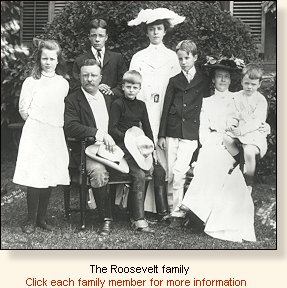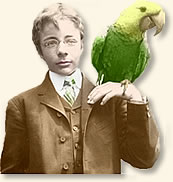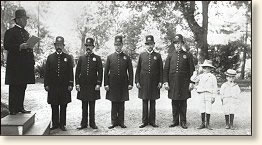|
The Roosevelts Move into
the White House, 1901
On September 6, 1901 an assassin's bullet tore into President William McKinley and eventually propelled Vice President Theodore Roosevelt to the presidency. McKinley was cut down while attending the Pan American Exposition in Buffalo, New York. TR was vacationing in New York's Adirondack Mountains when the news reached him. After a break neck ride to Albany, Roosevelt was taken by train to Buffalo and was present when McKinley succumbed to his wounds on September 14.
 Just shy of his forty-third birthday, Roosevelt was the youngest president to move into the White House. He, his wife and six children brought an energetic enthusiasm and vibrancy previously unknown in the presidential mansion. Along with the family came a virtual menagerie of pets - including dogs, birds and a pony. The Roosevelt's soon completely occupied the place making it their home and stamping it with their own unique imprint. Leaving the White House in 1909, TR remarked: "I don't think any family has enjoyed the White House more than we have." Just shy of his forty-third birthday, Roosevelt was the youngest president to move into the White House. He, his wife and six children brought an energetic enthusiasm and vibrancy previously unknown in the presidential mansion. Along with the family came a virtual menagerie of pets - including dogs, birds and a pony. The Roosevelt's soon completely occupied the place making it their home and stamping it with their own unique imprint. Leaving the White House in 1909, TR remarked: "I don't think any family has enjoyed the White House more than we have."
Ike Hoover served in the White House for over forty-two years, ultimately becoming Chief Usher in charge of the day-to-day operations of the presidential mansion. His memoirs, published in 1934, provide insight into the White House of Theodore Roosevelt:
"After the McKinley funeral Mr. Roosevelt himself did not appear for several days, but in the meantime Mrs. Roosevelt and her son Teddy arrived. After looking the place over they sent word to the others to join them, and in less than a week all the family were living in their new quarters. Then began the wildest scramble in the history of the White House. The children, hearty and full of spirits, immediately proceeded to cut loose.
The life of the employees who took their responsibilities too seriously was made miserable. The children left no nook or corner unexplored. From the basement to the flagpole on the roof, every channel and cubbyhole was thoroughly investigated. Places that had not seen a human being for years were now made alive with the howls and laughter of these newcomers. The house became one general playground for them and their associates. Nothing was too sacred to be used for their amusement, and no place too good for a playroom. The children seemed to be encouraged in these ideas by their elders, and it was a brave man indeed who dare say no or suggest putting a stop to these escapades.
One of the favorite stunts of the children was to crawl through the space between ceilings and floors where no living being but rats and ferrets had been for years. They took delight also in roller-skating and bicycle-riding all over the house, especially on the smooth hardwood floors. Practically every member of the family, with the exception of the President and Mrs. Roosevelt, had a pair of wooden stilts, and no stairs were too well carpeted or too steep for their climbing, no tree too high to scramble to the top, no fountain too deep to take a dip, no furniture too good or too high to use for leapfrog and horseplay, no bed was too expensive or chair too elegantly upholstered to be used as a resting place for the various pets in the household.
Giving the pony a ride in the elevator was but one of many stunts. This little fellow, spotted and handsome, had free access to any of the children's bedrooms. By means of the elevator he would be conveyed to the bedroom floor from the basement, a distance of two complete floors. As the children grew, there grew with them the idea on the part of the staff that such a situation was really necessary to the proper conduct of things. In fact it seemed as natural to the daily life of the White House as it was for an officer to arrest a crank or for the cook to prepare the meals."
 |
| Teddy Jr. and a Friend |
"...From the hour of rising in the morning plans
were immediately prepared as to how best to enjoy the day. Meal hours, office
hours,
school hours,
were all subject to change- to fit in with these plans. Nothing was ever known
to interfere - neither weather, company, business, nor anything else.
These pastimes took on all forms. First and foremost, of course, were the horseback rides. Every member of the family was an expert rider, and the President never seemed so happy as when either Mrs. Roosevelt or one of the children accompanied him on his ride. Next perhaps might be mentioned his lawn tennis games. It was great sport for him to figure just whom he preferred to play with in the afternoon. Of course none dared refuse the invitation, but it was well known that a poor player was never invited a second time."
"...Entering upon the daily routine, we found the entire
family down to breakfast at eight o'clock. After breakfast the President spent
an hour or so in his study, perhaps reading, while Mrs. Roosevelt arranged the
details of the day's program. The President went to his office at nine-thirty
or ten o'clock, and Mrs. Roosevelt for a walk or shopping, often accompanied
by her secretary or one of her many friends.
 |
Archie and Quentin Roosevelt (right)
with the White House Police |
All returned just about in time for lunch. Those famous lunches! Something indeed was wrong when there were not two or more guests for this meal. To prepare properly for a certain number was almost a physical impossibility, for notice was continually coming from the office that some one had been invited at the last minute, and many times the family and guests had to wait until the table was made larger before they could be seated. The place was really a transient boardinghouse, and how every one got enough to eat was the wonder of the household. Lunch being over, the rest of the afternoon was given over to sport - "exercise" as the President used to call it.
At one time it would be the famous Mike Donovan engaging in battles royal with the President and taking on one of the boys for a side issue. Then again it would be Joe Grant, the famous District champion wrestler, who would spend two or three hours at a time trying his prowess with the head of the nation and giving his points to the younger ones.
It was more to the liking of the family to spend a quiet evening in the library, either playing cards or reading the current magazines. The whole family were fiends when it came to reading. No newspapers. Never a moment was allowed to go to waste; from the oldest to the youngest they always had a book or a magazine before them. The President, in particular, would just devour a book, and it was no uncommon thing for him to go entirely through three or four volumes in the course of an evening. Like-wise we frequently saw one of the children stretched out on the floor flat on his stomach eating a piece of candy and with his face buried deep in a book. The current magazines were entirely too slow coming out, and we were kept busy trying to get them for the different members of the family the moment they appeared. And yet the Roosevelts were early birds, both in retiring and arising. Very seldom, unless something special was on hand, did they go to bed later than ten-thirty. In going out to dinner they made it a rule to make their departure promptly at ten o'clock, then home and immediately to their bedrooms."
References:
Hoover, Irwin Hood, Forty-two Years in the White House (1934); Seale, William, The President's House, vol II (1986).
How To Cite This Article:
"The Roosevelts Move Into the White House, 1901," EyeWitness to History www.eyewitnesstohistory.com (2003).
|






